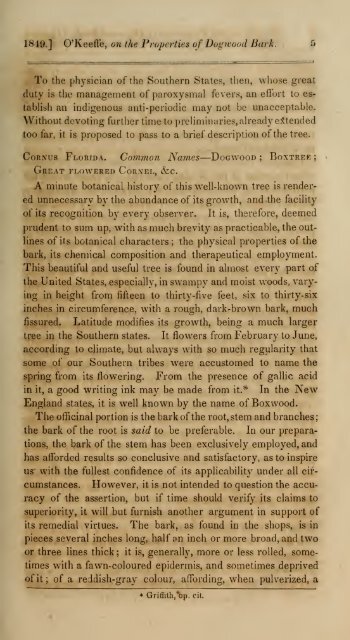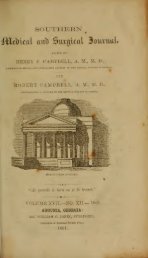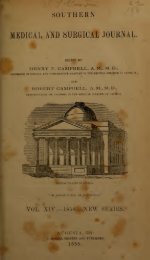1849.] O'Keefie, on the Properties of Dognwod Bark.To the physician of the <strong>Southern</strong> States, then,whose greatduty is the management of paroxysmal fevers, an effort to establishan indigenous anti-periodic may not be unacceptable.Without devoting further time to preliminaries, already extendedtoo far, it is proposed to pass to a brief description of the tree.CoRNUS Florida. Common Names— Dogwood ; Boxtree ;Great flowered Cornel, &c.A minute botanical history of this well-known tree is renderedunnecessary by the abundance of its growth, <strong>and</strong> the facilityof its recognition by every observer. It is, therefore, deemedprudent to sum up, with as much brevity as practicable, the outlinesof its botanical characters; the physical properties of thebark, its chemical composition <strong>and</strong> therapeutical employment.This beautiful <strong>and</strong> useful tree is found in almost every part ofthe United States, especially, in swampy <strong>and</strong> moist woods, varyingin height from fifteen to thirty-five feet, six to thirty-sixinches in circumference, with a rough, dark-brown bark, muchfissured. Latitude modifies its growth, being a much largertree in the <strong>Southern</strong> states.It flowers from February to June,according to climate, but always with so much regularity thatsome of our <strong>Southern</strong> tribes were accustomed to name thespring from its flow^ering. From the presence of gallic acidin it, a good writing ink may be made from it.* In the NewEngl<strong>and</strong> states, it is well known by the name of Boxwood.The officinal portion is the bark of the root, stem <strong>and</strong> branches;the bark of the root is said to be preferable. In our preparations,the bark of the stem has been exclusively employed, <strong>and</strong>has afforded results so conclusive <strong>and</strong> satisfactory, as to inspireus with the fullest confidence of its applicability under all circumstances.However, it is not intended to question the accuracyof the assertion, but if time should verify its claims tosuperiority, it will but furnish another argument in support ofits remedial virtues. The bark, as found in the shops, is inpieces several inches long, half an inch or more broad, <strong>and</strong> twoor three lines thick; it is, generally, more or less rolled, sometimeswith a fawn-coloured epidermis, <strong>and</strong> sometimes deprivedof it; of a reddish-gray colour, affording, when pulverized, aGriflith,*op. cil.
6 O'Keeffe, on the Properties of Dogwood Bark. [Januarygrayish powder tinged with red. The bark of the root is destituteof epidermis. The odour is sHght, <strong>and</strong> the taste verymuch Hke the Cinchona ; it is bitter, <strong>and</strong> astringent, with a littlearoma. Its astringency is, however, stronger than that of thePeruvian bark. It appears to be more particularly related tothe cinchona oblongifolia.Chemical Composition. Gum. resin, tannin, <strong>and</strong> gallic acid?were the result of Dr. Walker's analysis. To these have sincebeen added by Mr. Cockburn, oil, fatty matter, a crystallinesubstance, bitter extractive, wax, <strong>and</strong> colouring matter, lignin<strong>and</strong> potassa, iron, lime <strong>and</strong> magnesia.*prove that the extractive matter aloneHis experiments go tocontains the bitter principle,from which the crystalline substance is obtained.As to the propriety of admitting the existence of this alkaloidsubstance announced by Mr. Carpenter, the weight of authorityseems to preponderate against it. And Mr. C. has certainlyforfeited his claims to originality, (admitting its discovery,) bywithholding from the profession the process by which it wasobtained. Although the existence of this bitter principle haslong beenregarded a mooted point, nay, as one unworthy theattention of modern analysts, nevertheless, advocates are notwanting who assure us, that they have used the Sulphate ofCornine with as much, if not more, success, than the Sulphateof Quinine in intermittent fevers.The gratification of a scientific curiosity would suggest aninquiry into the source of such contrariety of opinion, resultingfrom the labours of analysts ;<strong>and</strong> a satisfactory explication isrevealed in the fact, that the investigations have been conductedunder incorrect principles. That Cornine constitutes aningredient of the Dogwood bark, <strong>and</strong> may be obtainedtherefrom,it is our design to demonstrate ; but that it possessesalkaline properties,<strong>and</strong> combines Avith acids, are fallacious inferencesthat have too long frustrated the sanguine anticipationsof the solicitous experimenter.It is due the kindness of Dr. Robert Campbell, to mentionhis valuable services in determining upon, <strong>and</strong> conducting theio\\o\\\w^^ process for obtaining theCornine:Pulverize two lbs. of the well-dried bark of the root ; separ-Ain. Juurn. Pharm., vol. ii., p. IM.
- Page 1 and 2: SOUTHERNMEDICAL AND SURGICAL JOURNA
- Page 3 and 4: 2 O'KeefCe, on the Properties of Do
- Page 5: 4 O'Keeffe, on the Properties of Do
- Page 9 and 10: y—8 O'Keefie, on the Properties o
- Page 11 and 12: 10 0'Keeffe,onthePrope7*tiesofDogtt
- Page 13 and 14: ;12 O'Keeffe, on the Properties of
- Page 15 and 16: ;14 O^Keeffe Jon the Properties of
- Page 17 and 18: ;:1 6 O'Keeffe, on the Proper^ties
- Page 19 and 20: 18 O^Keeffe, on the Properties of D
- Page 21 and 22: :60 O'KeefFe, on the Properties of
- Page 23 and 24: 22 O'Keeffe^ on the Properties ofDo
- Page 25 and 26: —24 O'Keeffe, on the Properties o
- Page 27 and 28: —26 O'Keeffe, on the Properties o
- Page 29 and 30: 28 O^Keeffey on the Properties of D
- Page 31 and 32: 30 Eve, on Clinical Surgery. [Janua
- Page 33 and 34: —American Medical Association.[Ja
- Page 35 and 36: American Medical Association.\)^rm.
- Page 37 and 38: —36 American Medical Association.
- Page 39 and 40: 38 American Medical Association. [J
- Page 41 and 42: American Medical Association.'[J an
- Page 43 and 44: ^ New Operation for Cure of Varicoc
- Page 45 and 46: 4^ Cases of Pneumonia Typhoides. [J
- Page 47 and 48: 46 Cases of Pneumonia Typhoides. [J
- Page 49 and 50: —Scrofula— its causes,[January,
- Page 51 and 52: 50 Treatment of Ganglion. [January,
- Page 53 and 54: —52 Monthfy Periscope. [January,f
- Page 55 and 56: ——54 Monthly Periscope. [Januar
- Page 57 and 58:
———56 Monthly Periscope. [Jan
- Page 59 and 60:
—58 Monthly Periscope. [January,R
- Page 61 and 62:
——so Monthly Periscope. [Januar
- Page 63 and 64:
§2 Monthly Periscope.— Medical I
- Page 65:
; 1164 Medical Intelligence. -Meteo








